In Care of the Historical Society of Woodstock: Selected Survey of Woodstock Art Colony Wks on Paper
- Bruce Weber
- Jun 2, 2023
- 23 min read
Updated: Dec 27, 2024
Bruce Weber with Maria Yeye
I hope you'll be able to attend the opening at the Historical Society of Woodstock on Saturday June 10th (from 1 to 5 p.m.) of the exhibition In Care of the Historical Society of Woodstock: A Selected Survey of Woodstock Art Colony Works on Paper, which I curated with Maria Yeye's assistance. I'll speak about the exhibition at 3:30 p.m., focusing especially on the four works the Historical Society is hoping to conserve with community support. In addition, I'll be giving a gallery talk on the exhibition on Saturday July 8th at 3 p.m. The exhibition closes on July 23rd.
The Historical Society of Woodstock is located at 20 Comeau Drive, and is open on weekends from Spring through Fall from 1 to 5 p.m. Admission is free. In addition to the current show, you'll have the opportunity to see the newly opened tool shed and permanent historical exhibition.
I'd like to thank Deborah Heppner for her valuable help in putting together the exhibition of works on paper, JoAnn Margolis and Letitia Smith for their collaborative work on the grant application, and John Kleinhans for providing needed photography.
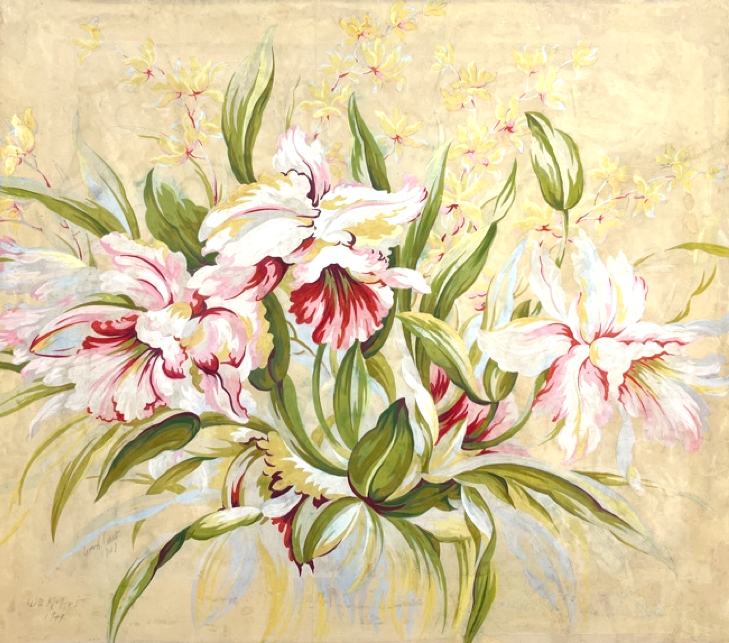
William H. Arlt (1868-1952)
Flowers, 1949
Gouache on paper
19 x 10"
Historical Sociaty of Woodstock 2007.27.269
The current exhibition at the Historical Society of Woodstock highlights the institution's significant collection of works on paper, the recently completed conservation by Sarah Dove of William H. Arlt’s Flowers, and the conservation needs of pictures by Marianne Appel, Judson Smith, and Harry Gottlieb. As a result of the generous support of the NYSCA/GHNN Conservation Treatment Grant Program, administered by the Greater Hudson Heritage Foundation over the past two years, conservation has been completed on Arlt’s Flowers, and the paintings Hervey White in His Studio, by Arnold Blanch, and Landscape, by Edmund B. Rolfe.
These efforts are part of a long-range plan to care for works in the fine art collections that are in special need of conservation, which will allow the greater public to become more aware of the strength of the institution’s fine art collection, and of the aesthetic achievements of the historic Woodstock art colony. It is our hope that with the support of people in the community we will soon undertake the care of the works by Appel, Smith, and Gottlieb. Information about the care and cost required of these four works is noted in the label text that appears below.
From the time of the Historical Society of Woodstock‘s inception in 1929, the organization has been devoted to recording, documenting, and furthering interest in the history of the Woodstock art colony. In late September of that year a group of 20 individuals gathered at the home of Konrad Cramer, including fellow artists Marion Bullard, Alice Wardwell, Eva Watson-Schütze, Zulma Steele, Henry Lee McFee, Florence Ballin Cramer, Orville H. Peets and H. L. Jenkinson. The Historical Society of Woodstock's fine art collection currently numbers about 800 works, and was largely assembled in the 1980s by Sam Klein, who served as director of acquisitions, with help from the organization’s president Matthew Leaycraft.
This exhibition highlights three areas of the fine art collection: portraits of leading local individuals, among them artists and musicians; townscapes, with views of noteworthy houses, streets, land, places of business and other local or area architecture, and village scenes, including public events and activities, and nearby farms; and the collection’s small but exquisite collection of still lifes. Among the works on view are self-portraits by Kurt Sluizer, Manuel Bromberg, Franklin Alexander, Leslie Bender, Robert Angeloch, Sally Michel Avery, March Avery and Daniel Gelfand, as well as likenesses by Judson Smith of artist and photographer Sam Wylie and illustrator Miska Petersham, and Aline Fruhauf’s caricature of the author J. P. McEvoy. Among the outdoor scenes are works by Clarence Bolton, Reeves Brace, Wilna Hervey, Doris Lee and Mary James. Still lifes include pictures by Ernest Fiene, Harry Gottlieb, Georgina Klitgaard, Mary D. Smith, and Milton Glaser.
PORTRAITS

Franklin Alexander (1929-2005)
Self Portrait, c. 1990
Pencil on paper
27 x 21” Historical Society of Woodstock, 2007.027.267
Painter, philosopher, writer and teacher Franklin Alexander was a native of New York City, and resided in Woodstock from 1955 to his death. After studying art in New York and working in advertising, he attended the State Art Institute in Florence in 1950 under the GI Bill, and began to devote his full attention to painting. Following a brief period as an abstract painter he began to specialize in figurative work and drawing in the early 1960s. Alexander was also active as a portraitist. This striking drawing served as a study for a self-portrait in acrylic of about 1990 (Estate of Franklin Alexander). Alexander taught widely, including at the Woodstock School of Art. In his classes in portrait painting he encouraged students to devote special attention to the analysis of facial expression and characterization, and shared his broad and thorough knowledge of classical methods and techniques.
BW
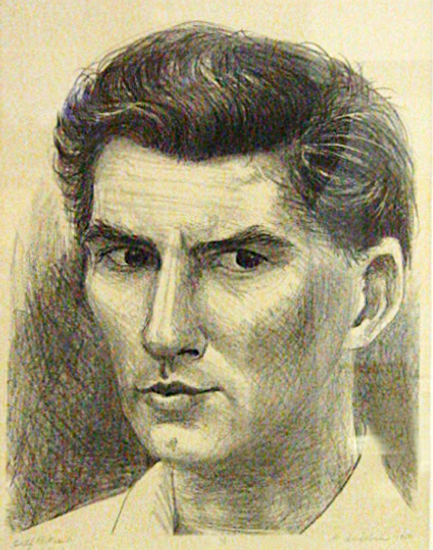
Robert Angeloch (1922-2011)
Self Portrait, 1950
Lithograph on paper
15 x 11”
Historical Society of Woodstock, 2007.027.024
Robert Angeloch attended the Art Students League in New York from 1946-1951, where he first began studying painting with Yasuo Kuniyoshi, and also attended Martin Lewis’ graphics class in etching and lithography. In 1948 he was the monitor in Kuniyoshi’s class at the league’s summer school in Woodstock. Angeloch took up permanent residence in Woodstock in 1953. He served as the principal founder of the Woodstock School of Art, which in 1981 moved to the league’s former site on Route 212 outside the village. In addition to having an active career as a painter, printmaker, and teacher, from 1975 to 2000 Angeloch ran the Paradox Gallery on lower Mill Hill Road, which was devoted to showing both the work of contemporary artists and artists of the historic art colony. It was the first gallery in Woodstock of its kind, preceding that of the James Cox Gallery and Fletcher Gallery.
BW
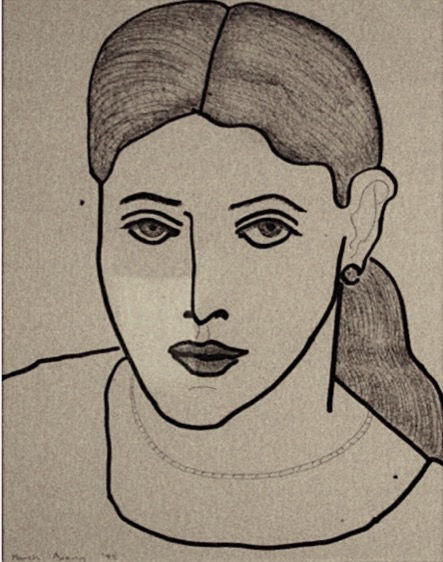
March Avery (B. 1932)
Self Portrait, 1988
Felt pen, black ink and wash on paper
13 ½ x 10 ½”
Historical Society of Woodstock, 2007.027.102
Daughter of painters Milton Avery and Sally Michel Avery, March Avery began painting as a child – although as she tells it, "I think I was painting in utero.” She began coming to the area for summers in the early 1950s when her parents resided in Byrdclifffe.
BW
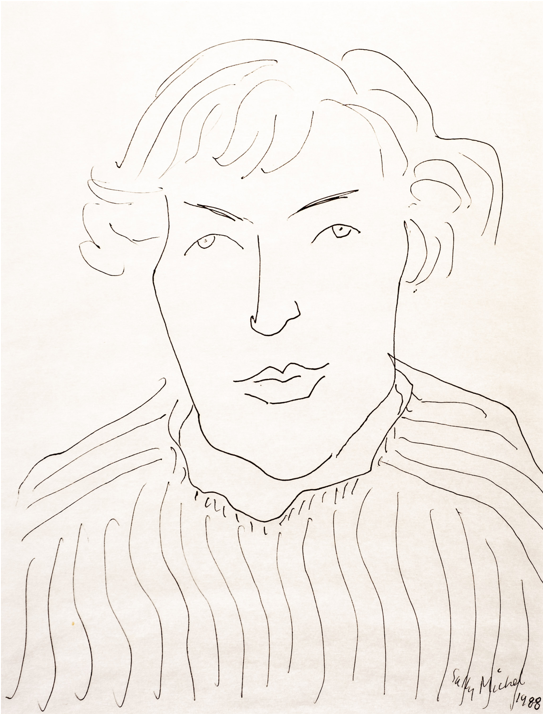
Sally Michel Avery (1902-2003)
Self Portrait, 1988
Pen and ink on paper
10 ¼ x 8 ¼”
Historical Society of Woodstock, 2007.027.084
Sally Michel Avery worked as a freelance illustrator for decades, enabling her husband Milton to paint fulltime. Following Milton's death in 1965, she devoted greater time to her own work, and had solo showings in Woodstock at the Jarvis and Bell galleries. Earlier she worked mostly on a small scale, and on paper. After Milton Avery’s second heart attack in 1960, the couple purchased a house in Lake Hill, near Cooper Lake. A few years after Milton’s death, Sally acquired ten acres of land in Bearsville, where she lived and worked during the summer months till her death in 2003.
BW
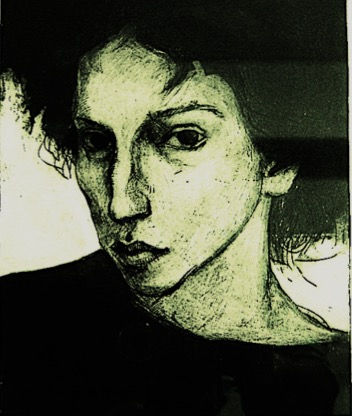
Leslie Bender (B. 1952)
Self Portrait, 1988
Etching on paper
10 x 8”
Historical Society of Woodstock, 2007.027.013
Leslie Bender first learned the art of etching and aquatint at the Art Students League in New York in 1972. Her next serious printmaking endeavor was at the Woodstock School of Art in 1986, when she served as the monitor in Robert Angeloch’s printmaking class. Bender, who has been active for almost forty years as an artist in the Hudson Valley, encouraged Angeloch to utilize the lithographic stones left by the league’s summer school following its departure in 1979 from Woodstock, where it had resumed its activity following World War II.
BW
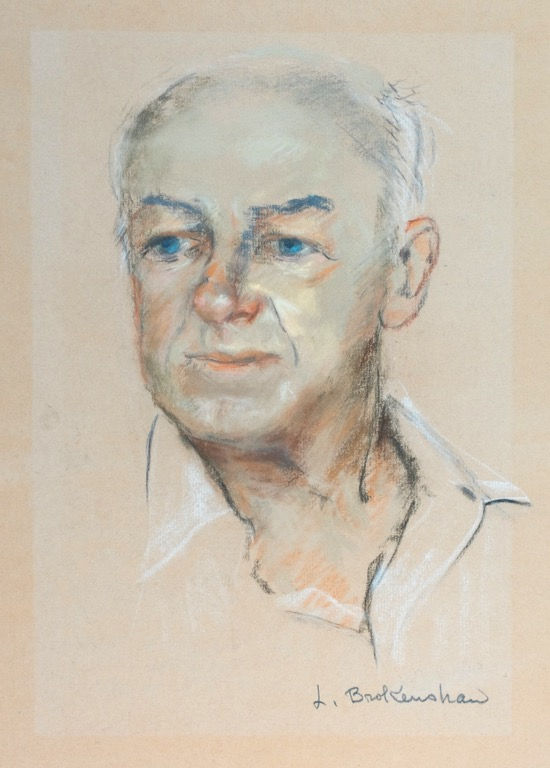
Louise Brokenshaw (1907-1992)
Portrait of Harry Cowell, 1973
Pastel on paper
19 x 14 ½”
Historical Society of Woodstock, 2007.027.177
Louise Brokenshaw focused primarily on ceramics. She was prominent in Woodstock for over thirty years beginning in the 1940s, and lived with her artist husband, Brock, in Shady, in a farmhouse they restored, which was built for the head of the colonial glass factory that
once operated there. She taught ceramics out of her home and through the Woodstock Guild of Craftsmen. This pastel portrait features Henry Cowell, the world-renowned avant-garde 20th century composer, musical theorist, pianist, teacher, publisher and impresario who beginning in 1942 had a home in Shady with his wife Sidney, a pioneering ethnomusicologist and folklorist. Among Cowell’s private students were John Cage and Lou Harrison.
MY
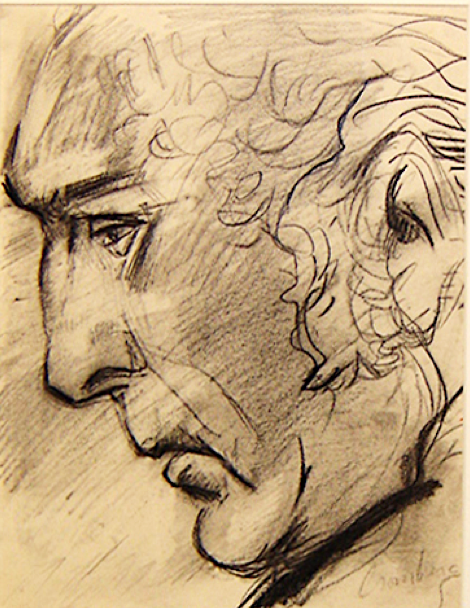
Manual Bromberg (1917-2022)
Self Portrait, 1955
Charcoal on paper
11 x 8”
Historical Society of Woodstock, 2007.027.219
Manuel Bromberg was first drawn to Woodstock in 1941 by the painter Arnold Blanch, who invited the young artist to stay with him. He briefly returned to the area in 1950 when he and his wife lived in the Maverick art colony in West Hurley. Bromberg settled permanently in town in 1957 after he accepted a teaching position at SUNY New Paltz. In the mid-1950s, the artist was highly active as a portraitist. In 1954 he was commissioned to paint portraits of several of the NATO Generals. Among Bromberg’s later more abstract work is a series of innovative, monumentally scaled “Cliff Sculptures,” which were inspired by the landscape of the Catskills and cast in polyester and fiberglass.
MY
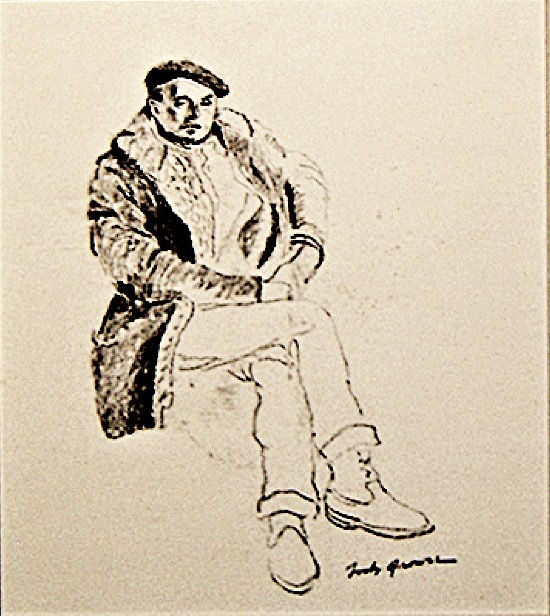
Tode Brower (1898-1974)
Portrait of Carl Walters, 1935
Charcoal on paper
11 x 9”
Historical Society of Woodstock, 2007.027.175
Tode Brower came to Woodstock in the late 1920s with his artist wife, Jo Cantine, and settled in Bearsville. During the winters, the couple traveled throughout the Caribbean, Mexico, and Central America, gaining inspiration for their work. Although Brower painted mostly in watercolor, he was commissioned in 1935 by the WPA to paint a mural for the new armory in Kingston. The subject of this portrait, Carl Walters, was a painter and printmaker turned ceramic sculptor who came to Woodstock in 1922. Walters joined the Maverick art colony, where he focused on hand-molding sculptures and producing complex and original glazes for his work. A lithograph by Walters is featured in this exhibition.
MY
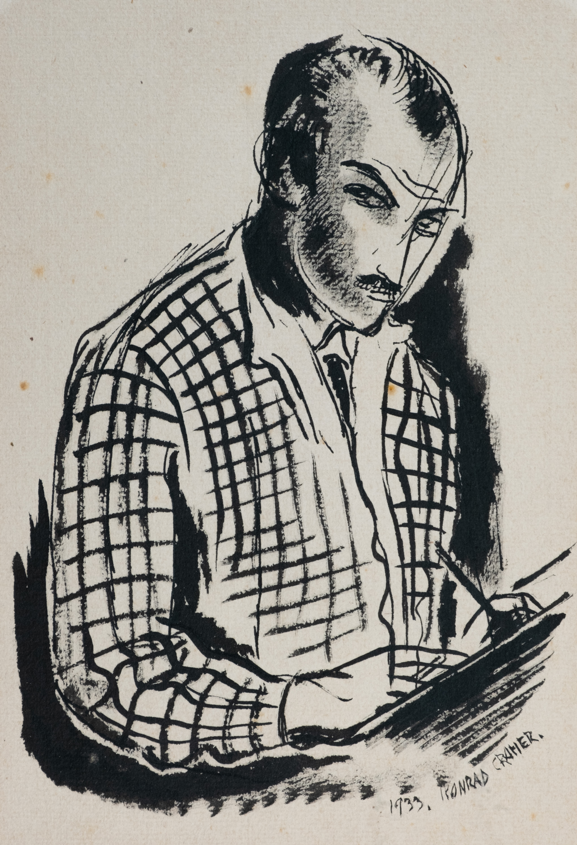
Konrad Cramer (1888-1963)
Self Portrait, 1933
Ink, pen and brush on paper
8 x 5 ½”
Historical Society of Woodstock, 2007.027.162
Konrad Cramer was always open to working in new techniques, styles and media. A native of Germany, he met the aspiring painter Florence Ballin in Munich in early 1912. Following their marriage, they settled in Woodstock, where Florence had previously been studying, living and working. Cramer was deeply involved in the Woodstock community. Among other things he played a role in the founding of the Historical Society of Woodstock. During the Great Depression, Cramer seriously questioned the place that artists of the day had in relation to society. In 1933, he wondered what “place an artist had in relation to his time, of what social and ethical importance has he, is he showing a clearer way to a better life?”
BW

Julio de Diego (1900-1979)
Self Portrait, c. 1970
Lithograph on blue paper
20 x 16 ½”
Historical Society of Woodstock, 2007.027.009
The flamboyant Julio de Diego was born in Madrid, and left home at the age of 15. In 1924 he emigrated to the United States, where he became active in the art world of Chicago. In the late 1940s he exhibited with the Surrealists in Paris. Diego first visited Woodstock in 1950, and moved permanently to the town in 1961. Art writer Lester Burban remarked that the artist’s “fierce and mobile face, framed in jet black hair, is startlingly lighted by a pair or paradoxically compassionate forget-me-not blue eyes. It is not surprising, with his dramatic demeanor, that he acted in one of the early Spanish movies, was an extra with the Russian Ballet and a pantomimist with a Spanish theatrical company in Tampa, Florida.”
BW

John Fenton (1912-1977)
Self Portrait, c. 1960
Graphite on paper
17 x 12”
Historical Society of Woodstock, 2007.027.007
Painter, printmaker, poet, art critic and teacher John Fenton was born in Mountaindale, New York. He attended the Art Students League of New York and Atelier 17 in Paris. Among his teachers was the Surrealist Frederico Castellón. Fenton taught at New York University, Goddard College and the Gedney School of Art. He and his artist wife, Sophie Fenton, lived for many years in Mount Vernon, New York. In 1948, they began summering in Woodstock, and in 1969 moved there permanently. In an article in the Woodstock Times in 2002 Fenton was fondly recalled as “a thin, bearded man with great energy and humor.”
BW

Aline Fruhauf (1907-1978)
Caricature of J. P. McEvoy, c. 1930
Pen and ink and gouache on paper
8 2/3 x 4 2/3”
Historical Society of Woodstock, 2007.027.201
Aline Fruhauf established a major reputation in the 1920s as a caricaturist of writers, artists, musicians, and actors. She spent summers in Woodstock in the early 1930s, where she created caricatures of artists Yasuo Kuniyoshi, Eugene Speicher, and Konrad Cramer, and the writer J. P. McEvoy, among others. McEvoy achieved renown as a playwright and scripter of the popular Dixie Dugan comic strip drawn by Woodstock illustrator John H. Striebel. In the 1920s and early 1930s, McEvoy and his artist wife Eugenie presided over a 20-acre estate in Bearsville, which included a manor house, two studios, a stable, and an Olympic-sized swimming pool.
BW
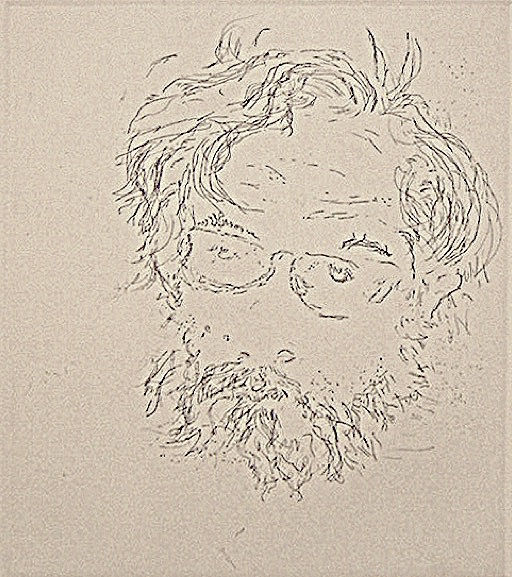
Daniel Gelfand (B. 1948)
Self Portrait, 1980
Etching on paper
12 ¾ x 9 ¾”
Historical Society of Woodstock, 2007.027.193
A native of Queens, Daniel Gelfand studied art at several schools in New York, including Southampton College, the Brooklyn Museum Art School, and the New York Studio School, and completed graduate work at C. W. Post College and SUNY New Paltz. He initially came to the Woodstock area in 1973, when he lived with his wife Jennifer in Mount Tremper. While residing later in Shokan he became close with artists André Ruellan and John W. Taylor. Following Taylor’s death in 1983 he built a house on the couple’s property in Shady. For many years Gelfand was deeply involved with the Woodstock artistic community.
Gelfand became interested in etching while studying printmaking in 1983 with Ben Wigfall and Joe Ramos at SUNY New Paltz. Self Portrait was his initial work in the medium. He drew six self-portraits on paper, placed them in front of himself, then proceeded to draw the image on the etching plate while editing from all six. He recalls that Taylor thought that Self-Portait “was terrific for a first etching.” In the course of the 1980s and 1990s, the artist was deeply engaged with etching and monoprints, and was active as a printer for other artists, including Ruellan and Norma Morgan. Gelfand currently resides in Saugerties.
BW
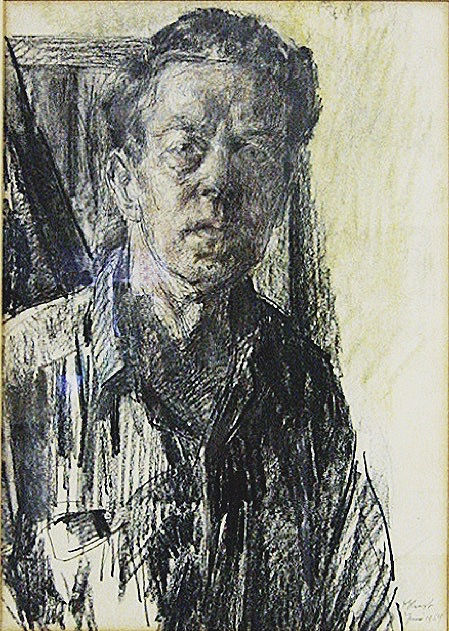
Kurt Sluizer (1929-2009)
Self Portrait, June 1959
Charcoal, crayon and chalk on paper
16 ¼ x 11 ½”
Historical Society of Woodstock, 2007.027.036
Kurt Sluizer was born in Holland and moved to the United States in 1939. He lived briefly in Reno, Nevada, then moved permanently to Woodstock in 1943. He was experimental in his mediums and subjects, working in oil and pastel, making lithographs, and focusing on a range of subjects including portraits, still lifes, interiors, and landscapes.
MY
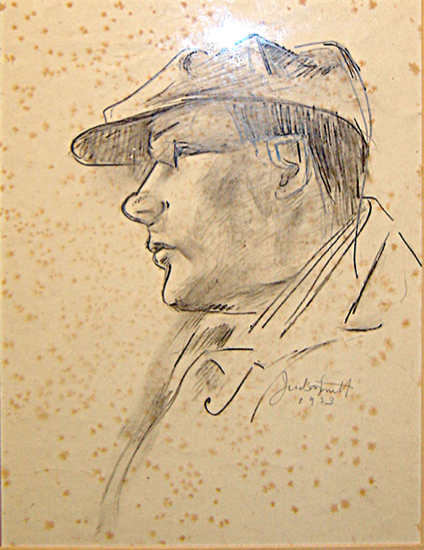
Judson Smith (1880-1962)
Sketch of Miska Petersham, 1923
Graphite on clay-coated wove paper
12 x 9”
Historical Society of Woodstock, 2007.027.242
Judson Smith was a native of Michigan. In 1921, he and his artist wife Mary left Detroit for a trip abroad. On returning to America later that year they visited Woodstock, where Judson was impressed by the art he saw on view at the Woodstock Artists Association, and was convinced the community would be stimulating. He settled with his family on part of the old Risely farm on Ohayo Mountain Road.
Smith occasionally depicted artists he associated with in town, including Miska Petersham and Sam Wiley. Miska and his wife Maud were acclaimed writers and illustrators of children’s books. Born in Hungary, he traveled to New York in 1911, where he found work at the graphic studio International Art Service. He met Maud across the drawing board. The couple married in 1917, and in 1923 settled near the village of Woodstock in a house on the Glasco Turnpike.
BW
In order to conserve Smith’s drawing, the paper conservator Sarah Dove will need to remove tape and adhesive from verso, water wash with filtered pH adjusted water to reduce soluble discoloration in the sheet, reduce discoloration with ammonium citrate dibasic, further water wash to remove chemicals, consider light bleaching to reduce the foxing further, size with methyl cellulose to further protect the paper, minimize the strong creases by lining the back of the drawing with Japanese paper and wheat starch paste.
Conservation Estimate: $625.00
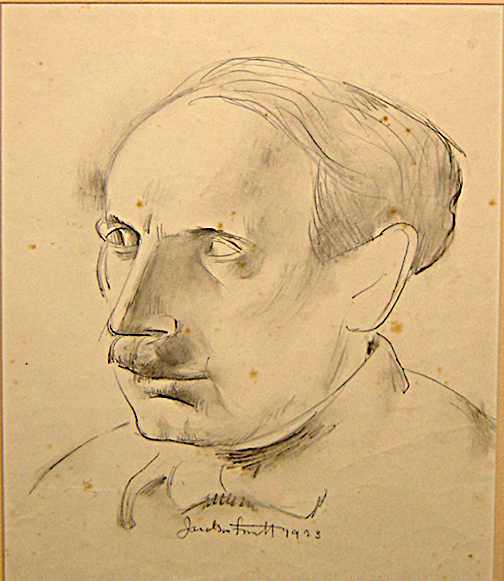
Judson Smith (1880-1962)
Sketch of Sam Wylie, 1923
Graphite on clay-coated wove paper
12 x 9”
Historical Society of Woodstock, 2007.027.241
Sam Wylie was born in Indiana and grew up in Pennsylvania. Shortly after graduating in 1905 from Indiana University (where his grandfather was the school’s first president), he attended classes at the Art Students League of New York, and then came to study in Woodstock with Birge Harrison at the league’s Woodstock School of Landscape Painting. A pioneer of the art colony, Wylie was active as a landscape painter and photographer.
BW
In order to conserve Smith’s drawing, the paper conservator Sarah Dove will need to water wash with filtered pH adjusted water to reduce soluble discoloration in the sheet, reduce discoloration with ammonium citrate dibasic, further water wash to remove chemicals, consider light bleaching to reduce the foxing further, size with methyl cellulose to further protect the paper, minimize the strong creases by lining the back of the drawing with Japanese paper and wheat starch paste, and fill the losses with a comparable paper toned to match.
Conservation Estimate: $625.00
TOWN, CITY AND FARMSCAPES
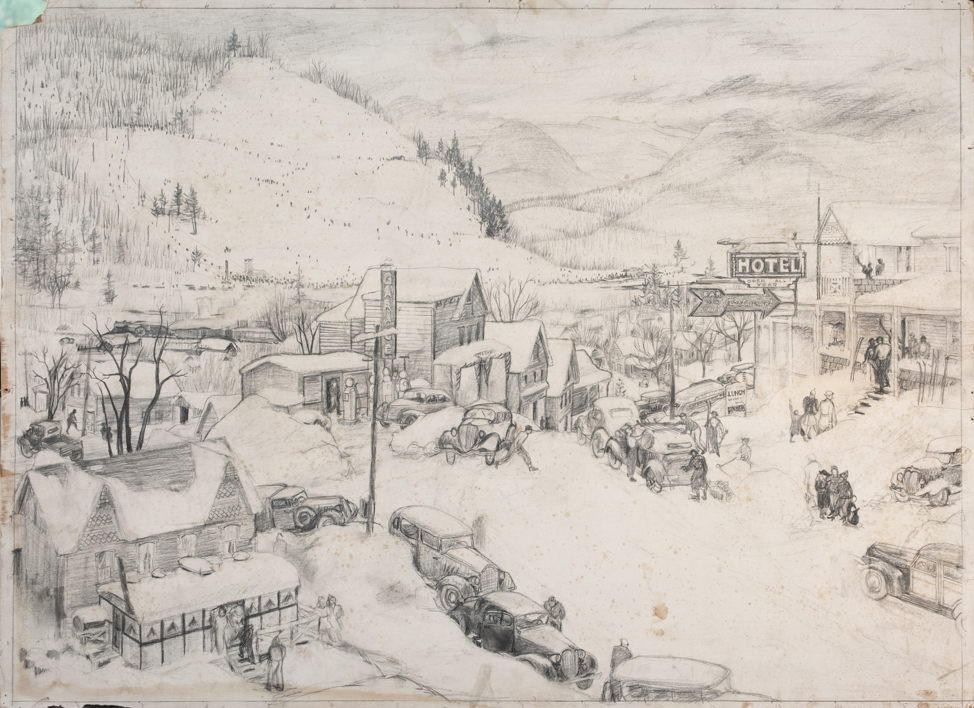
Marianne Appel (1913-1988)
Ski Town, c. 1941
Graphite on paper
23 x 30 ¾”
Historical Society of Woodstock, 2007.027.677a-c
Marianne Appel grew up in New York City. From 1932-1934 she attended Sarah Lawrence College and studied art with Peppino Mangravite and Bradley Walker Tomlin, a longtime resident of the art colony, who may have inspired Appel to attend the Woodstock School of Painting in the summer of 1934. There she studied with Charles Rosen, Konrad Cramer, Henry Lee McFee, Henry Mattson, and Austin Mecklem, whom she married two years later. Ski Town is a working drawing for the artist’s unlocated oil painting of the same title, which was shown at the Carnegie International in Pittsburgh in 1941. The location of the town is not known for certain, but it is probably based on a view of Phoenicia. Following Mecklem’s death in 1951, Appel relocated to New York City, where she achieved acclaim as a designer and fabricator of puppets for television and film productions.
BW
In order to conserve Appel's drawing, the paper conservator Sarah Dove will have to mechanically remove the cardboard backing board to the adhesive layer with a scalpel (retaining the authentication stamp on the verso), reduce the adhesive as possible with the appropriate solvent, water wash with filtered pH adjusted water to reduce soluble discoloration in the sheet, reduce discoloration with ammonium citrate dibasic, further water wash to remove chemicals, consider light bleaching to reduce the foxing further, line overall with Japanese paper and wheat starch paste, and mylar encapsulate the authentication stamp removed from the verso.
Conservation Estimated Cost: $2,750.00
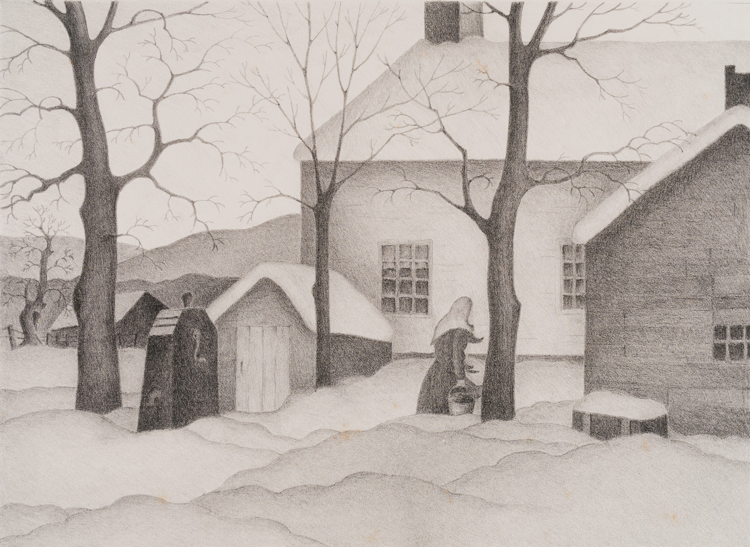
Clarence Bolton (1893-1962)
After the Storm, February 1938
Lithograph on paper
9 ½ x 12 1//4”
Historical Society of Woodstock, 2007.027.094
Painter, graphic artist and printmaker Clarence Bolton first settled in Woodstock in 1917. His interest in lithography developed in 1938 while he was engaged with the WPA art project, and worked closely with printer Grant Arnold, creating prints of familiar scenes and places around town, including people doing chores and activities common to country life.
BW
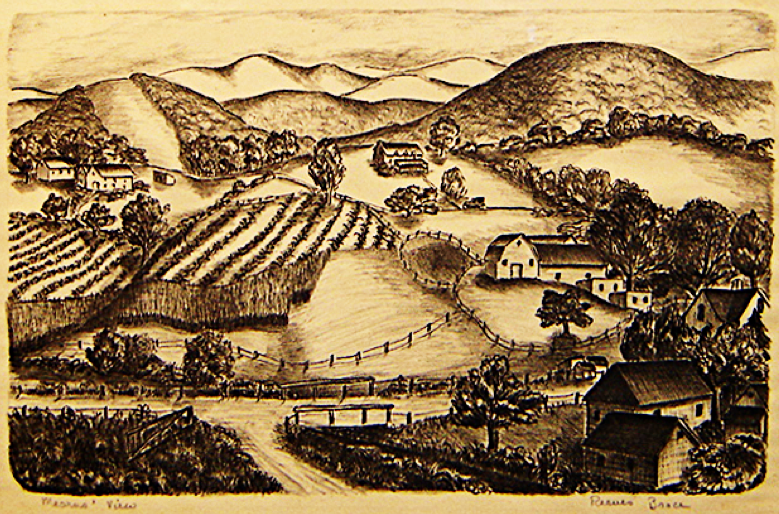
Reeves Brace (1898-1934)
Mearns’ View, c. 1930-1932
Lithograph on paper
12 x 16”
Histoical Society of Woodstock 2007.027.223
Reeves Brace and her husband, the writer and craftsman Ernest Brace, began spending summers in Woodstock in 1924. They probably were drawn to the art colony by Peggy Bacon, who formed a friendship with Reeves at the Art Students League in New York. About a dozen oils, drawings and prints are currently known by Reeves. The group includes landscapes, still lifes, animal subjects and a sporting scene. Mearns’ View features the view from the Bearsville property of author and educator Hughes Mearns.
BW
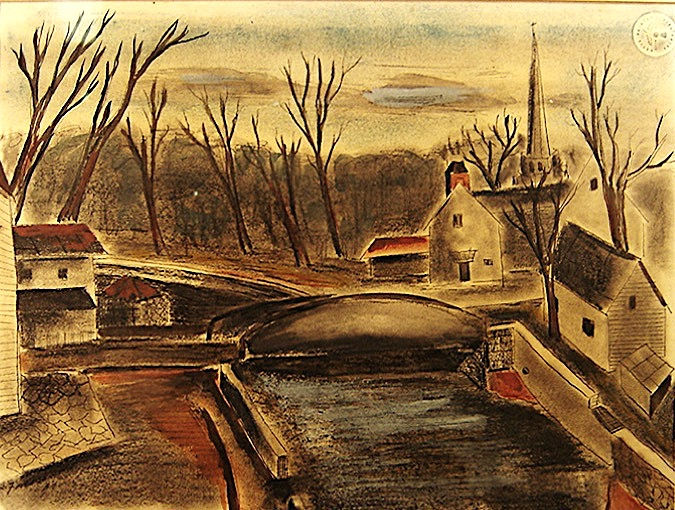
Karl E. Fortess (1907-1993)
Woodstock Village, 1934
Ink and gouache on paper
10 x 13”
Historical Society of Woodstock, 2007.027.083
Karl E. Fortess attended the Art Institute of Chicago in the late 1920s, and then moved to New York City. From there he hitchhiked north, unsure of whether he wanted to travel to the artist colony in Woodstock or Provincetown, Massachusetts. During the course of his expedition he visited a police station to learn which place was closer. He hitchhiked the rest of the way to Woodstock and arrived with a few cents in his pocket. A person gave him a lift to West Hurley, where he met Maverick art colony founder Hervey White, who gave him an attic room to live in. At the Woodstock School of Painting, Fortess came under the tutelage of Yasuo Kuniyoshi, whose work influenced his direction and style as a landscape painter. Fortess remarked that during his formative years in the colony there were “two kinds of artists . . . younger or older, with a kind of protective arrangement between them.”
BW
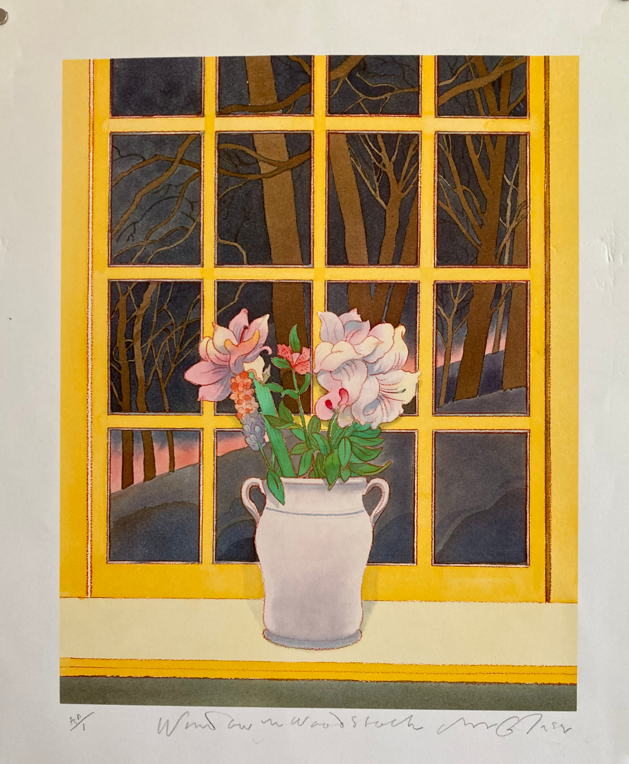
Milton Glaser (1929-2020)
Window in Woodstock (Flowers in a Vase), 1986
Serigraph on paper (Artist's Proof)
Historical Society of Woodstock, 2007.027.213
Milton Glaser, a renowned artist and graphic designer, joined the Woodstock community as a seasonal resident in the 1950s and continued coming regularly for the rest of his life. He was best known for cofounding New York Magazine, and designing the iconic "I [heart] NY" graphic. He created illustrations for a wide range of uses, such as album covers, advertisements, postcards, playbills, menus, and stationery. Many of his illustrations were created to inspire tourism in New York State, like this view of Woodstock, which the town utilized to promote tourism.
MY
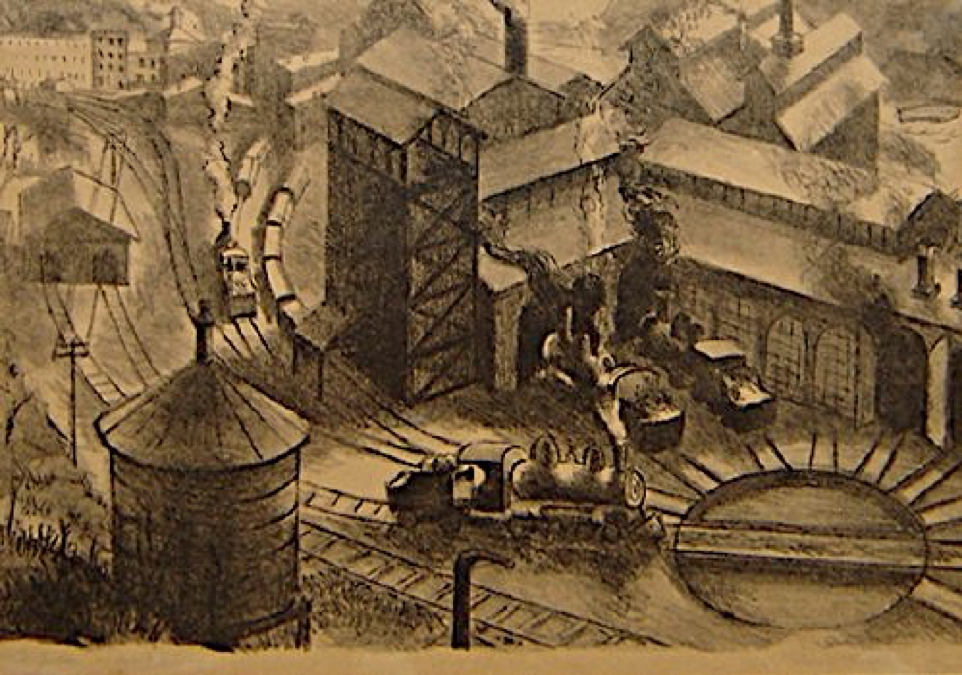
Harry Gottlieb (1929-2020)
The Roundhouse, 1930
Lithograph on wove paper
13 ½ x 18 1/2”
Historical Society of Woodstock, 2007.027.385
Harry Gottlieb regularly discovered interesting material in Kingston, where he depicted brickyards, railroads, and barges, and created his arresting image of the train repair shop in the Rondout section of the city, printed in Woodstock by Grant Arnold. A still life by the artist is also included in the exhibition.
BW
In order to conserve Gottlieb’s lithograph, the paper conservator Sarah Dove will need to mechanically remove the pressure-sensitive tapes from the verso, reduce the adhesive with the appropriate solvent, water wash with filtered pH adjusted water to reduce soluble, discoloration in the sheet and remove the paper tapes, reduce discoloration with ammonium citrate dibasic, further water wash to remove chemicals, consider light bleaching to reduce the foxing further, and size with methyl cellulose to further protect the paper.
Conservation Estimate: $750.00
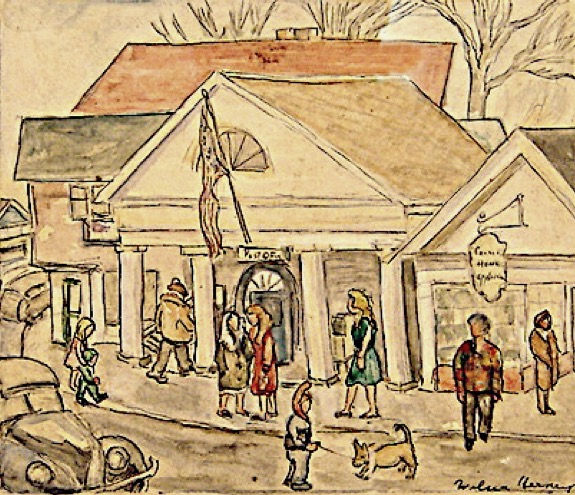
Wilna Hervey (1894-1979(
Woodstock Post Office, 1945
Waterclor and ink on paper
6 ½ X 7 ¾”
Historical Society of Woodstock, 2007.027.121
Early in life Wilna Hervey became well known for her role as Katrinka in a series of two-reel live action silent comedies based on the popular comic strip Toonerville Trolley. She first came to Woodstock in 1918 when she attended Winold Reiss’ summer art school. In 1924, she and her artist partner Nan Mason settled on a 4 ½ acre mountainside property in Bearsville. At the end of World War II, Hervey had an artistic breakthrough when artist Henry Lee McFee urged her to abandon her interest in drawing portraits in a traditional style indebted to Reiss’ example, and develop her own more personal vision. Working in various media, Hervey developed a folk art style, and pictured still lifes and images of local sites, such as the village green and post office.
BW
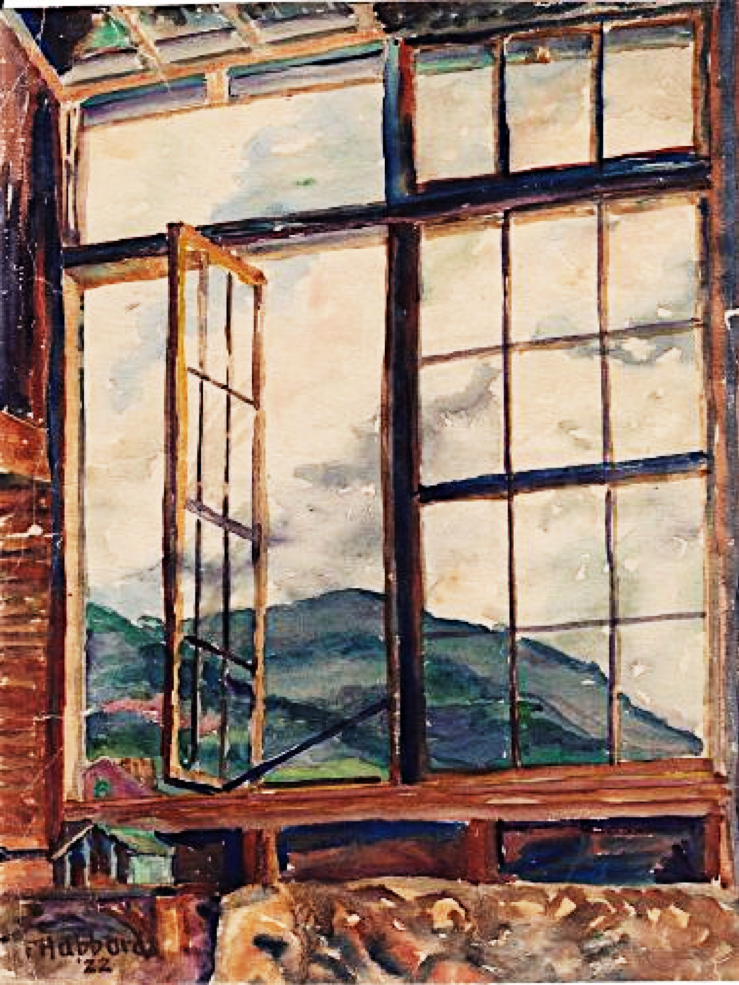
Florence Tuttle Hubbard (1892-1968)
View of Overlook Mountain from Artist’s Studio Window in Bearsville, 1922
Watercolor on paper
20 x 16
Historical Society of Woodstock, 2007.027.527
The little remembered artist Florence Tuttle Hubbard was born in Hartford, Connecticut in 1892. In 1921 she began a long career as an art teacher in the New York City School system, first teaching at Boys High School in Brooklyn and then at Flushing High School in Queens. Hubbard first came to Woodstock in 1920, when she studied at the Art Students League’s summer school. In about 1922, Hubbard began spending summers in Bearsville. In 1938 she bought a house on Wild Rose Hill in the hamlet. Following her retirement around 1950, Hubbard spent most of her time upstate. She was involved with several local organizations (including the Woodstock Garden Club). and developed a new interest in weaving. View of Overlook Mountain from Artist’s Studio Window in Bearsville reveals Hubbard’s creative approach to tackling outdoor subjects. and arresting sense of composition
BW
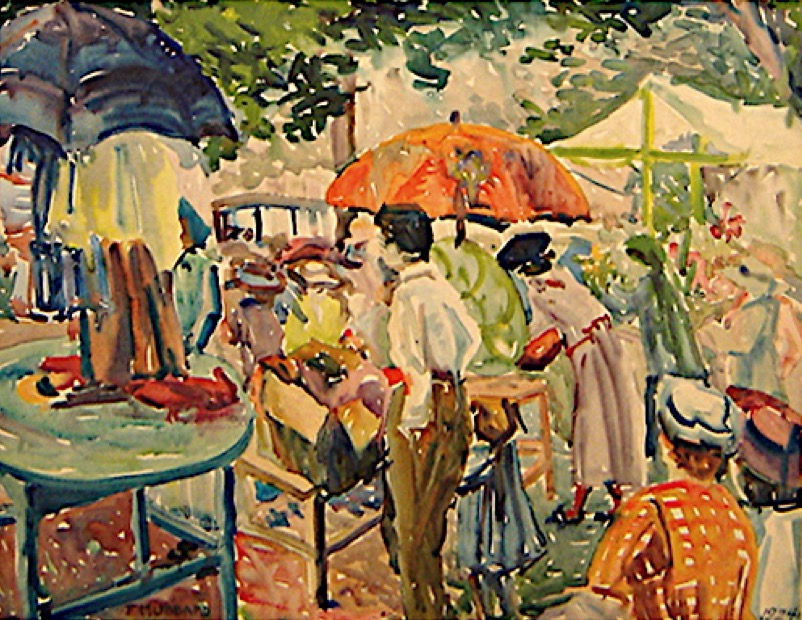
Florence Tuttle Hubbard (1892-1968)
Scene of Market Fair, 1924
Watercolor on paper
10 ½ X 13 1/2”
Historical Society of Woodstock, 2007.027.280
Hubbard’s lively and richly hued watercolor of the local Market Fair dates from 1924. For more than three decades the fair was held every Saturday near the village green during the summer months. Woodstock historian Janine Fallon-Mower has noted that the artist Ethel Peets “developed the idea of Saturday Market Fairs in 1917 as a way to raise money for the Red Cross. Ethel and Marion Eames set about gathering a group of volunteer workers to run a street fair, patterned after similar fairs that were common in Europe. Table sellers, as they were known, set up on a vacant lot behind the village green in an area now occupied by the Garden Café.” Among other things, the fair was a popular place to buy flowers, jewelry and interesting odds and ends. The fair survives today in the guise of Mower’s Saturday Sunday Flea Market on Maple Lane in the village.
BW
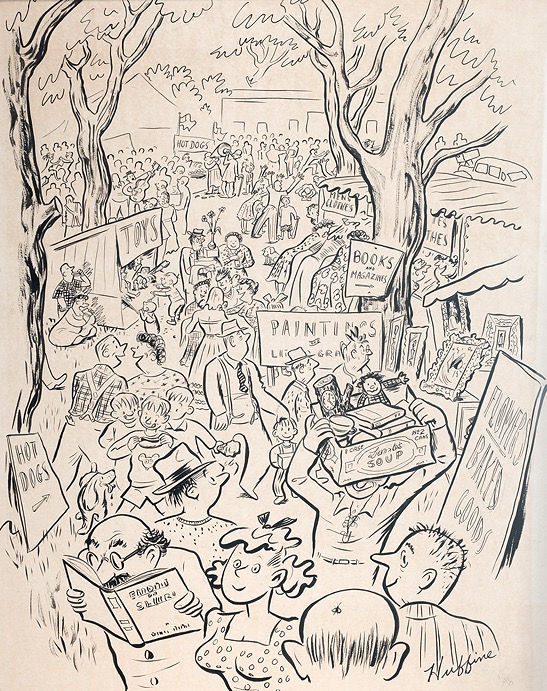
David Huffine (1911-1973)
Library Fair, 1948
Ink on paper
25 x 20”
Historical Society of Woodstock, 2007.027.135
David Huffine was born in Knoxville, Tennessee, and began his residency in Woodstock in 1938. Trained at the Art Students League, he became a well-known cartoonist, producing humorous works emblematic of the 1940s and 50s. Both Huffine and Florence Tuttle Hubbard have pictures of the Woodstock Market Fair in this exhibition. The Library Fair has been held on the home grounds in front of the library since 1931, four years after the library moved to its present home. The fair itself goes back to 1917 when it was begun as a fundraiser for the library when there was no library budget. From 1927-1946 the library borrowed the tent and tables belonging to the Saturday afternoon Market Fair, and the Library fair was held on Wednesday to avoid interference. The Kingston Daily Freeman reported that at the 1948 Library Fair the “crowd was larger. The costumes, booths, personalities and just about everything was gayer and livier than ever before.”
BW
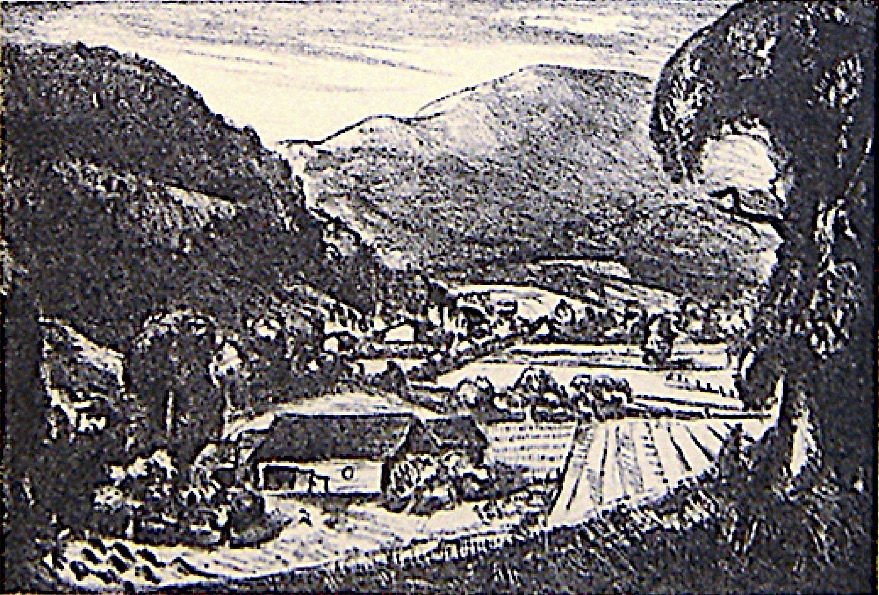
Neil Ives (1892-1946)
Untitled, 1923
Lithograph on paper
6 ½ x 9 ¼”
Historical Society of Woodstock, 2007.027.423
Neil Ives was a native of St. Louis , where his father, Halsey C. Ives, was founding director of the St. Louis Art Museum. After attending the Pennsylvania Academy of the Fine Arts and the Art Students League of New York, Ives came to Woodstock in 1913 to study at the league’s summer school, and eventually decided to settle here. He and his wife, the artist Dorothy Greenwood Ives, lived on a knoll behind the present library and Orchard Lane. In the early 1920s, Bolton Brown, George Bellows, Andrew Dasburg, Henry Lee McFee, Konrad Cramer and Ives were among a small group of colony artists working with lithography.
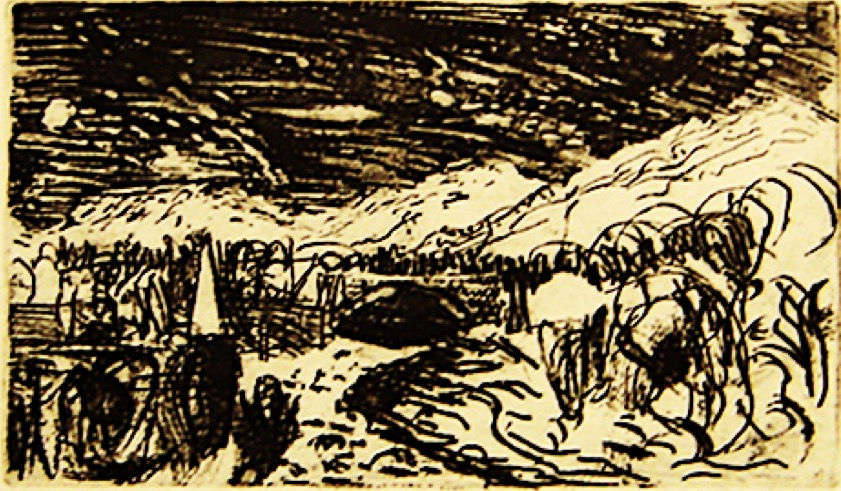
Mary James (Born 1959)
Night Winter Storm View of Woodstock (Winter Storm), 1986
Etching on paper
6 ¾ x 10”
Historical Society of Woodstock, 2007.027.181
Mary James is the granddaughter of historian Alf Evers, with whom she resided in Shady from 1982-1999. James grew up in Switzerland, and studied at the École Nationale Superieure des Beaux Arts in Paris and Goldsmith’s College in London. Soon after moving to the area in 1982 she became interested in printmaking, and discovered “so much possibility in black and white.” She served as a printmaking instructor at the Woodstock School of Art, and in 1987 formed a support group with local artists Richard Pantell, Daniel Gelfand, Tim Slowinski, and Ernest Frazier. James’ prints of the period were usually made from direct observation in the landscape and from her experience of being outdoors in all kinds of weather. The etching in the exhibition is the only etching she created at the time that was based on a dream. James currently resides in White Plains, New York.
BW
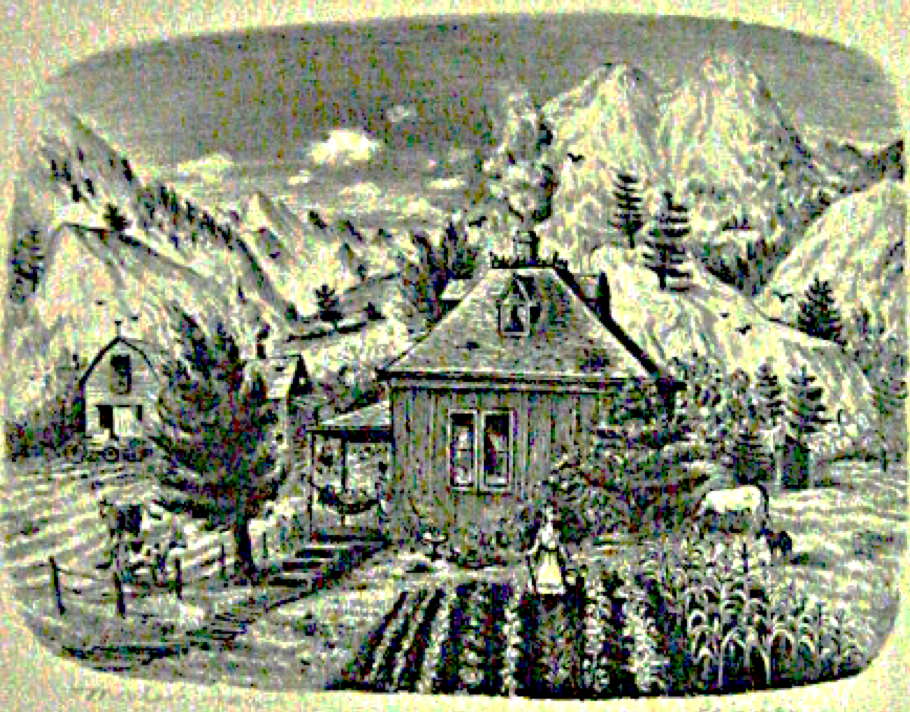
Doris Lee (1905-1983)
Mountain Farm, c. 1942
Lithograph on paper
7 x 8 ¼”
Historical Society of Woodstock, 2007.027.109
Painter and printmaker Doris Lee attended the California School of Fine Arts in San Francisco in 1930, where she studied with visiting instructor Arnold Blanch. The following year she was drawn to Woodstock by Blanch, with whom she later had a long-term relationship. In 1942, Lee acquired six acres of land outside the village, with a large farmhouse, red barn, apple orchard and view of the mountains. The house (located at the juncture of route 212 and Chestnut Hill Road), had formerly been owned by artist and local philanthropist Alice Wardwell. The house’s backyard kitchen garden and barn resemble the those garden and barn that appear in in Mountain Farm, which dates from the early 1940s. Lee’s art at the time was grounded in her study and admiration for American Folk art of the 19th century, portraying country life with a sense of whimsy and joy.
BW
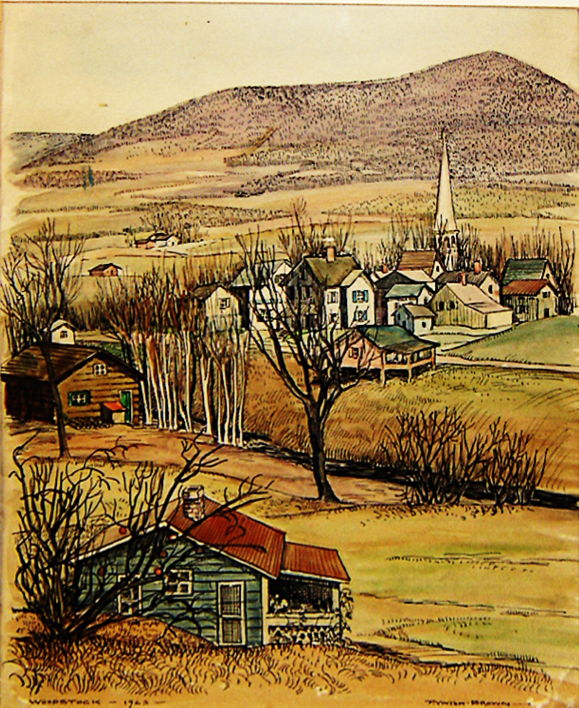
Patricia Hart Vinton Brown Ravenal (1883-1955)
Woodstock, 1923
Ink and watercolor on paper
14 ½ x 10 ½”
Historical Society of Woodstock, 2007.027.422
Patricia Hart Vinton Brown Ravenal was born in Brookline, Massachusetts, and was the great-granddaughter of British-born architect Benjamin Latrobe. Following her divorce from Hans Stunz in 1917, she began splitting her time between Woodstock and St. Mary's, Georgia. Best known for her miniature portraits, she was also active as an oil painter, watercolorist and woodblock printer. Ravenal created carefully observed landscapes of the Hudson Valley, as well as whimsical scenes drawn entirely from her imagination.
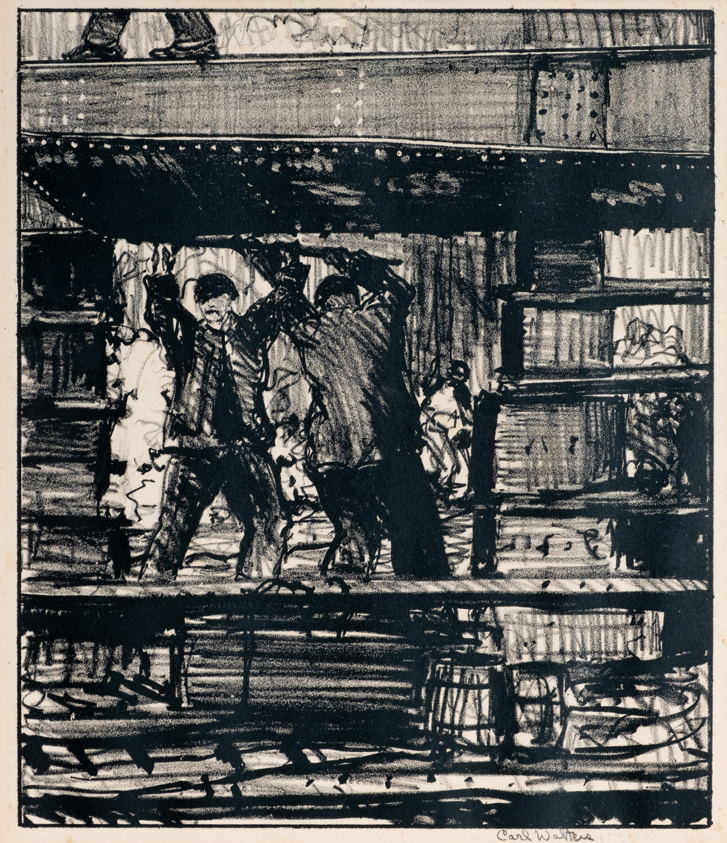
Carl Walters (1883-1955)
Two Men (Raising the Plate), 1920
Lithograph on paper
10 ¼ x 8 ¾”
Historical Society of Woodstock, 2007.027.125
Walters was born and raised in Fort Madison, Iowa, and studied at the Minneapolis School of Fine Arts and the New York School of Art. In 1912, Walters and his wife Helen moved to Portland, Oregon, where he painted seascapes, wharf and circus scenes. In 1919, he was commissioned to illustrate the Portland shipyards’ contributions to the World War 1 effort. He visited the local shipyards at all hours of the day and night, and created sketches of men at work on the huge boats, which formed the basis for his series of 30 lithographs documenting the local ship building industry. In 1922, art writer and curator William Murrell invited Walters to Woodstock, where he settled on the Maverick in West Hurley, and established a major career as a ceramic sculptor.
BW
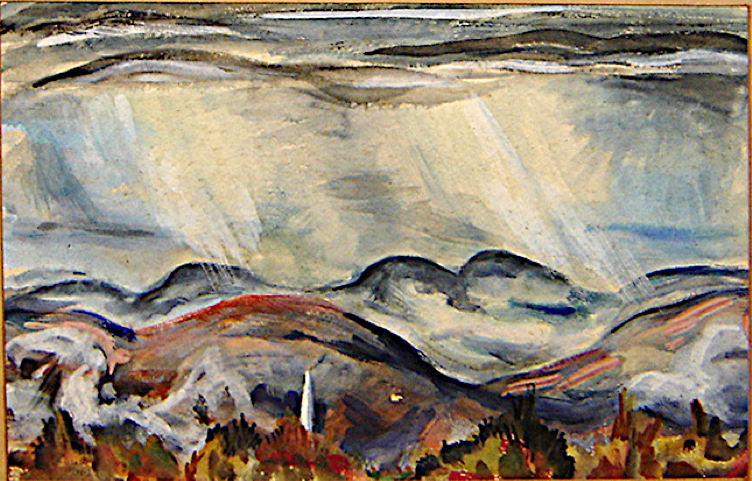
William Duke West (Active 1930s)
Woodstock Landscape, 1937
Gouache on paper
9 ¾ x 14”
Historical Society of Woodstock, 2007.027.234
The little-known William Duke West was active in Woodstock in the 1930s. This radiant landscape was donated to the Historical Society of Woodstock by Tom and Yvonne Riley. Tom Riley is the author of the recently published memoir More Light: An Artist’s Life with Meher Baba, in which he discussed his life and times in Woodstock, and his study in 1947 and 1948 with the artist Walter Goltz, whose home and studio is the present site of the Historical Society of Woodstock.
BW
STILL LIFES

William H. Arlt (1868-19529)
Flowers, 1949
Gouache on paper
19 x 22”
Historical Society of Woodstock, 2007.027.269
William Henry Arlt was a prominent textile designer and teacher. Born in Breslau, Germany, he fled the country at age 12 to escape growing militarism. With his brother and mother, he settled in New Jersey and studied commercial art. Arlt established his own offices in the city, served as president of the American Textile Designers Guild, and taught at the Textile Evening School of Design, among other places. He first came to Woodstock in 1906, and studied painting under Birge Harrison. After summering in Woodstock for several years, Arlt built a group of artists’ cottages on the hillside along Glasco Turnpike, and established a small art and design school. A great lover of flowers, Arlt worked in his extensive gardens in his spare time, and created a group of vibrant and colorful floral still lifes.
For her work on Arlt’s Flowers, paper conservator Sarah Dove, mechanically removed the construction paper window mat and corrugated backing board to the adhesive layer with a scalpel, reduced the adhesive as possible with acetone, humidified, flattened between blotters and weight, mended tears, and filled losses with a comparable paper toned to match.
BW
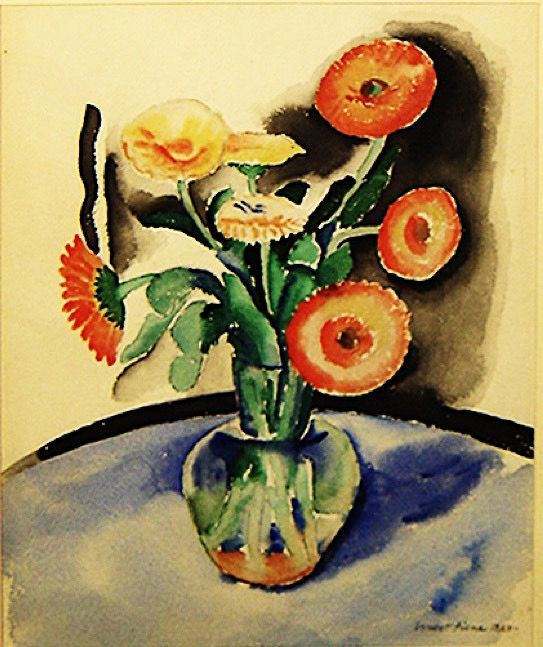
Ernest Fiene (1894-1965)
Still Life, 1924
Watercolor on paper
19 x 13 ¾”
Historical Society of Woodstock, 2007.027.247
Ernest Fiene was born in Elberfield, Germany, and immigrated to America with his family in 1912. His sculptor brother Paul came to Woodstock in 1919, when he bought several acres of property from the artist Caroline Speare Rohland, on what today is Speare Road. The following year Ernest joined his brother, and built a home and studio on the property. In the early 1920s the Fiene brothers (and Paul’s wife, the artist Rosella Hartman) were part of a tight-knit circle of artists and writers in town that included visiting poet Hart Crane and sculptor Gaston Lachaise. For ten years Woodstock was Ernest’s principal residence, and a major source of landscape subjects for his work. He also created floral still lifes, often featuring zinnias. He was included in an exhibition of flower pictures at Wanamaker’s Department Store in New York City in 1920, which featured fellow Woodstockers Paul Rohland and Konrad Cramer.
BW
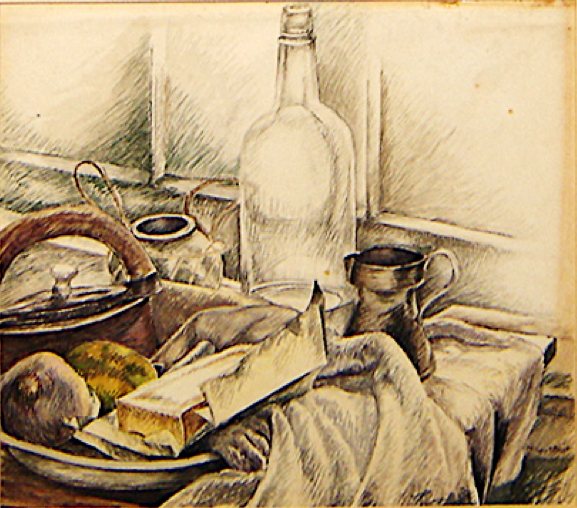
Harry Gottlieb (1929-2020)
Still Life, 1930
Watercolor and graphite on paper
8 ½ X 9 ½”
Historical Society of Woodstock, 2007.027. 238
Born in Romania, Harry Gottlieb settled with his family in Minnesota in 1907. From 1915-1917 he studied at the Minneapolis School of Fine Arts, where his fellow students included future Woodstockers Arnold Blanch, Lucille Blanch, and John Flannagan. Gottlieb lived in the Maverick art colony in West Hurley from 1922 to 1934, where he specialized in depicting landscape and industrial subjects, while creating an occasional tabletop still life. A lithograph featuring the Rondout in Kingston is also featured in the exhibition.
BW
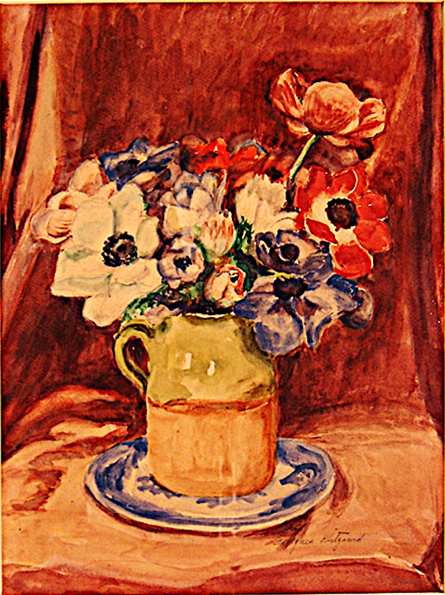
Georgina Klitgaard (1893-1978)
Still Life, c. 1940
Watercolor on paper
13 x 10”
Historical Society of Woodstock, 2007.027.075
Born in New York City, Georgina Klitgaard graduated from Barnard College and attended classes at the National Academy of Design. In 1917, she married the Danish mariner, writer and artist Kaj Klitgaard. They came to visit friends in Woodstock in 1920, and fell in love with the area. The couple bought a house on a steep ledge at the end of Cricket Ridge high above Bearsville, which provided panoramic views of the mountains and valleys of Woodstock. Best known for her landscape paintings of upstate New York, Klitgaard also created numerous still lifes of flowers in watercolor.
BW
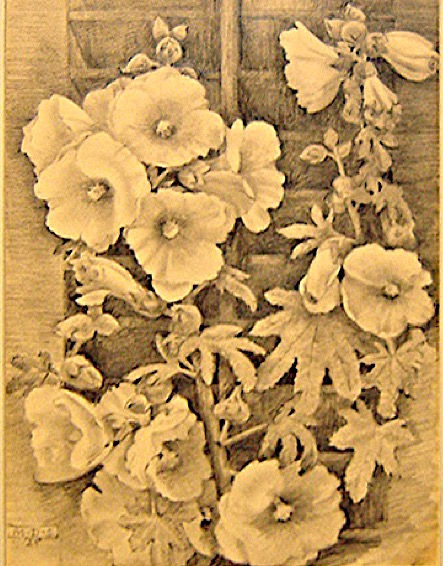
Mary D Smith (1877-1967)
Hollyhocks, 1923
Graphite on paper
13 x 9 ½”
Historical Society of Woodstock, 2007.027.282
Mary D. Smith was born in Detroit, Michigan, and moved to Woodstock in 1922. She was the wife of artist Judson Smith, whose work is also featured in this exhibition. Mary was one of the founders of the Woodstock Guild of Craftsmen, and was mostly active as a craftsperson. She began producing batiks, an Indonesian technique of wax-resistant dyeing, as early as 1918. She continued to produce these designs on fabric, which she called table pieces, for the rest of her career. In 1948, she started the Crafts Cooperative in Woodstock, a shop where craftsmen could sell their goods to help fund their crafts.
MY



Comentarios